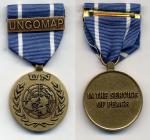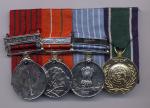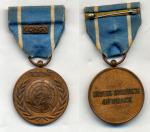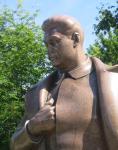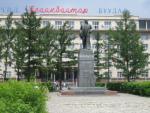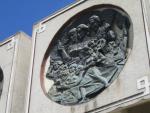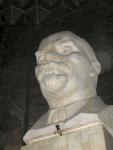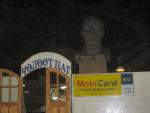-
Posts
14,343 -
Joined
-
Last visited
-
Days Won
25
Content Type
Profiles
Forums
Blogs
Gallery
Events
Store
Everything posted by Ed_Haynes
-

1914 "Mons" Star
Ed_Haynes replied to Riley1965's topic in Great Britain: Orders, Gallantry, Campaign Medals
OK, Doc (and sorry never to have answered off-line). Thanks for these, as they may provide a tutorial and practice in reading MICs. I must admit to being a novice (as all the Indian ones were pitched out, they are on scant interest to me). However . . . You have a flock of R. Coopers here, but only one your boy. There were, after all, 99 "R. Cooper"s killed in the Great War (per CWGC website -- http://www.cwgc.org/ .) The key will be his service number. And what you show as "Page 1" is his (post #14). The other "pages" are other people, though some of them very interesting ones. T-22885 Driver Robert Cooper entered a theatre of war as an Army Service Corps transport driver on 14 August 1914. While the theatre is not specified, it was, of course, France. He was in at the beginning as part of the 1st Railway Supply Depot. However, as there is no annotation of a clasp (as there is for post 16, for example), he must never have driven close enough to the action to be considered "under fire". It wasn't easy, even with fast-moving fronts, for ASC types to get the clasp. And not all 1914 Star recipients earned the clasp, though may felt they deserved it and later added it. He was alao awarded a British War Medal and a Victory Medal (which are somewhere out there awaiting reunification!) and finally made it to Acting Substantative Sergeant by war's end. Checking the medal rolls (they give the roll and page number) might tell you more. The 1914 Star roll might be especially interesting, as he is on page 1 of the ASC/17 roll. Just as a footnote, these medals were sent out to him on 27 August 1920, just over six years since he went into the war. -
Well put, Rick. I'd like to hear the thoughts of our China-based forum members??
-
Well, if someone buys this, I'd not call the seller "stupid". But, at least for now, no one has bid on this abomination. And yet the seller has a 99.2% positive rating. And their other "Chinese" awards are of equally high quality. While the collecting and study of other areas has taken off, scum such as this fellow and the dreck he markets mayl kill, forever, the collecting of Chinese ODM. Hope they're happy (though this particular fellow is mostly jewelry, it seems) and, with 4126 feedbacks and a "Power Seller", I bet he is happy.
-

Albania Hero of the People / Hero of Socialist Labor
Ed_Haynes replied to Bob's topic in Southern European & Balkan States
Is the black stripe inked-on? -
That'd be my guess, Kevin! "Repro"? Nice word.
-
I'd agree with Ulsterman. I think many are getting confused by the plastic covering that has badly discolored.
-
The second ribbon. I don't seem to have one loose. Here's a group to 1097408 Sweeper Asa Ram, Armoured Corps (Indian Army); though the group has been "dipped" and his Videsh Seva Medal has been rather "chewed", it is still a nice group.
-
In other threads, there has been considerable discussion of the United Nations' medal for service in the Operation des Nations Units au Congo (ONUC). ONUC conducted some fairly active and ugly "peacekeeping" in the Congo, 1960-64. ONUC was established by S/RES/143 (1960) of 14 July 1960. The ?CONGO? bar was authorized in July 1960; the revised ribbon was approved in 1963. Countries providing troops to ONUC included Argentina, Austria, Brazil, Burma (now Myanmar), Canada, Ceylon (now Sri Lanka), Congo, Denmark, Ecuador, Ethiopia, Ghana, Greece, Guinea, India, Indonesia, Iran, Ireland, Italy, Liberia, Malaya, the Federation of Mali (now Mali and Senegal), Morocco, the Netherlands, Nigeria, Norway, Pakistan, the Philippines, Sierra Leone, Sudan, Sweden, Tunisia, the United Arab Republic (later Egypt and Syria), and (former) Yugoslavia. The first ribbon and clasp.
-
Remember, please, that the same medal and ribbon combination was also used for UNTSO (1948-67) and UNOGIL (1958) as well as the first ONUC ribbon (1960-64, with clasp) and for UNGOMAP (1988-90, with clasp). The intent was that this medal would be THE peacepeeping medal and ribbon for the UN, while the Korea medal would be the UN medal for places where people got shot. This overly simple plan never stood up, of course. Someday, I hope someone looks at the relevant UN records and tells the tale. Irish troops served in all four: UNTSO, UNOGIL, ONUC, and UNGOMAP. For reliable information on UN medals, see http://www.un.org/Depts/dpko/medals/ although it does not (strangely) include UNOGIL. Megan's site -- http://www.medals.org.uk/united-nations/un...s--ribbons1.htm -- does. For more information on peackeeeping operations, see http://www.un.org/Depts/dpko/dpko/index.asp.
-

Romania Rumanian Order of the Star, 5th Class
Ed_Haynes replied to Riley1965's topic in Central & Eastern European States
Lovely! (But it does need a category move.) -

Mongolia Lenin museum in Ulan Bator
Ed_Haynes replied to Bryan's topic in People's Republic Mongolia
-

Mongolia Lenin museum in Ulan Bator
Ed_Haynes replied to Bryan's topic in People's Republic Mongolia
Maybe, Mike. But at least they are "in place" and have had a better life than their "cousins" in Moscow. -

Mongolia Lenin museum in Ulan Bator
Ed_Haynes replied to Bryan's topic in People's Republic Mongolia
-

Mongolia Lenin museum in Ulan Bator
Ed_Haynes replied to Bryan's topic in People's Republic Mongolia
-

Mongolia Lenin museum in Ulan Bator
Ed_Haynes replied to Bryan's topic in People's Republic Mongolia
-

Mongolia Lenin museum in Ulan Bator
Ed_Haynes replied to Bryan's topic in People's Republic Mongolia
-

Mongolia Lenin museum in Ulan Bator
Ed_Haynes replied to Bryan's topic in People's Republic Mongolia
A few more images of the snooker hall (nee Lenin Museum). Hard to photograph inside, very dark. Was once a MUST SEE for pioneers. -

Workers of the World . . .
Ed_Haynes replied to Ed_Haynes's topic in Central & Eastern European States
-

Republic of Ireland Irish Medals at Auction
Ed_Haynes replied to Ceallach's topic in Northern European & Baltic States
You spared us the estimate: ?40000-50000 -

Albania Hero of the People / Hero of Socialist Labor
Ed_Haynes replied to Bob's topic in Southern European & Balkan States
Interesting. More than just "interesting"? Are the fakers branching out, learning things we wish they didn't know??



